A Glossary of Diesel Terms
This page offers brief explanations of some diesel terms for the benefit of those who are unfamiliar with diesel engineering and its terminology. Perhaps it can also serve as a novice's guide to some basic elements of diesel technology. Written by a non-expert for non-experts, please contact me if you have suggestions for additions, amendments or improvements.
Aftercooling: A technique employed with two-stage turbocharging. It is basically the same as intercooling except that in a two-stage turbocharging system the charge air is intercooled after the first, low-pressure, stage of compression and aftercooled after the second, high-pressure, stage of compression.
Air-Blast Injection: Form of injection generally used on large early compression-ignition engines. The charge of fuel was 'blasted' into the cylinder by compressed air supplied from a compressor driven by a second engine or by the engine itself. The technology was superseded by 'solid' or 'mechanical' injection, as generally used today.
Airless or Mechanical or Solid Injection: The now generally used method of forcing fuel into the combustion space, using a pump to deliver the fuel at high pressure to the injector nozzle. (Compare air-blast injection).
Akroyd Stuart, Herbert (1864-1927): Although the invention of the compression ignition engine is commonly attributed to Dr Rudolph Diesel, the principles of this type of engine were first described in Akroyd Stuart's patent of 1890, two years before Diesel's patent. By 1892 Akroyd Stuart's engines were being built by Richard Hornsby & Sons Ltd of Grantham and marketed as Hornsby-Akroyds. Had the course of history run differently, we might now talk about Akroyds or Akroyd Stuarts rather than diesels!
Bank: Line (row) of cylinders on each side of a vee form or twin bank engine. Those on one side are referred to as A bank, and on the other side as B bank. Cylinders in each bank are individually numbered and identified as A1, A2, A3, … , B1, B2, B3, … , etc. Paxman's long-standing practice was to view its engines from the free end, calling the left bank 'A' and the nearest cylinder A1. However, not all engine manufacturers followed this convention and the official ISO notation starts from the flywheel end (normally the drive end) with A bank on the left, and cylinder A1 nearest the flywheel.
bhp - brake horsepower: Measure of an engine's power output after making allowances for friction and other energy losses within the engine. Today power output of larger engines is generally quoted in kWb (kiloWatt brake). One bhp = 745.7 Watts (0.7457 kWb), although a conversion factor of 746 is generally used.
Block pump: Type of fuel pump embodying a number of plungers (equal to the number of engine cylinders) within a single unit or block. The plungers are operated by a camshaft also contained within the block. Each plunger acts as a pump, feeding fuel oil under high pressure to an injector. Contrast individual fuel pumps, as used on some large diesels like the Paxman Valenta, where the pump for each injector is a separate stand alone unit, and unit pump injectors where the pump and injector are incorporated in a single unit as on the Paxman VP185.
bmep - brake mean effective pressure: A measure of engine rating. It is the average (mean) pressure which, if imposed on the pistons uniformly from the top to the bottom of each power stroke, would produce the measured (brake) power output. It cannot be measured directly and is calculated from bhp. The bmep of an engine is that part of its imep (indicated mean effective pressure) considered to contribute to the bhp, after taking account of the imep used to overcome frictional and other internal losses in the engine itself.
Boost / Boost Pressure: Pressure under which air for combustion is fed into the cylinders of an engine with turbocharging or supercharging.
Brake or Water Brake: Device for putting an engine under load, typically when it is on test. See also Dynamometer.
Bridge piece: Small metal component which bears down on the stems of two inlet or two exhaust valves. One rocker lever acting on the bridge piece can thus be used to operate two valves simultaneously, halving the number of rocker levers required in an engine with two inlet and two exhaust valves per cylinder.
Büchi, Dr Alfred (1879-1959): Chief Engineer of Sulzer Brothers Research Department in Switzerland, who developed the first exhaust driven turbocharger between 1909 and 1912, based on an idea he patented in 1905.
Cam follower: Component fitted between the end of a push rod or valve stem and the camshaft lobe which operates it. Also known as a tappet, its purpose is to reduce wear, particularly on the camshaft, and achieve smooth operation of the valve gear. Some cam followers incorporate a roller which is held in contact with the camshaft lobe and follows its profile.
Camshaft: Shaft with cams or lobes, used to operate valve gear and/or fuel pumps. Driven from the crankshaft by gears or a chain, in a four stroke engine it rotates at half the speed of the crankshaft.
Cetane Rating: Measure of quality of diesel fuel with reference to its 'ignition quality' or ability to ignite and its speed of combustion. The scale runs from 0 to 100, with most commercially available fuels having a rating of about 45 to 50. Cetane ratings only apply to distillate fuels. The quality of residual fuels (residues of fractional distillation at oil refineries), also called heavy fuel oils, is rated by reference to the CCAI (Calculated Carbon Aromaticity Index). Heavy fuel oils generally need to be heated before they will flow satisfactorily and are used, for example, in very large two stroke marine diesels.
Charge or Combustion Air: Air for combustion fed into a cylinder before compression and the injection of fuel. The quantity of air available for combustion is critical as it limits the amount of fuel which can be fully burned and converted to useful energy.
Charge Air Pressure: see Boost Pressure and Naturally Aspirated.
Charge cooling: see intercooling.
Clearance Volume: (of a cylinder) The space in the top of the cylinder into which the piston never intrudes. It is into this clearance volume that the charge air is compressed during an engine's compression stroke.
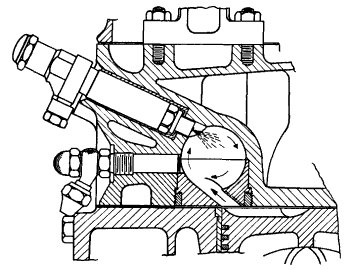 Comet Chamber: Small spherical chamber built into the cylinder head of an indirect injection engine. Fuel is injected into this chamber where initial combustion takes place before travelling along a narrow passage or throat to the cylinder. The Comet chamber was developed by Sir Harry Ricardo and was widely used on Paxman's early high speed diesels, on the wartime TP engines and all the post-war RPH and RPL engines.
Comet Chamber: Small spherical chamber built into the cylinder head of an indirect injection engine. Fuel is injected into this chamber where initial combustion takes place before travelling along a narrow passage or throat to the cylinder. The Comet chamber was developed by Sir Harry Ricardo and was widely used on Paxman's early high speed diesels, on the wartime TP engines and all the post-war RPH and RPL engines.
Common Rail: Type of fuel injection system widely used on modern high-speed diesels. Originally developed within the automotive industry, it is increasingly being used on large diesels as well. A delivery pump maintains fuel at a constant high pressure in a single manifold (chamber or pipe) per bank of cylinders. From here it is distributed through high pressure pipes to the injectors. Each injector is fitted with a solenoid valve, opened electronically from a control unit which governs both the starting point and duration of injection. Fundamental differences from previously standard systems are that control of injection is exercised at the injector rather than the pump and that control is handled electronically rather than mechanically using a camshaft. Advantages of common rail are that only one relatively simple fuel pump is required, not one per injector, and that injection can be controlled much more precisely with potential performance and economy benefits.
Another key advantage is that injection pressures are no longer engine speed dependent, so high injection pressures can be maintained throughout the speed range. High injection pressures give better atomisation of fuel in the cylinder, resulting in reduced particulate emissions. The downside is an increase in NOx emissions resulting from the higher rate at which cylinder pressure rises during combustion.
Disadvantages of common rail are more complex and costly injectors and the risks inherent in having a manifold containing fuel under very high pressure. Common rail injection was not adopted for any Paxman-designed engine.
Compression Ignition: Method of ignition used in diesel engines. High compression of the charge air leads to a sufficient rise in temperature to cause spontaneous ignition when fuel is injected into the cylinder. (Contrast spark ignition, where a spark is created to ignite the fuel as in petrol engines.)
Compression Ratio: Ratio of volume of air in a cylinder at air (inlet) valve closure to its volume at end of compression stroke. Alternatively it can be defined as the ratio of the sum of the swept volume and clearance volume to the clearance volume. The ratio is higher in a diesel than in a petrol engine, to achieve the rise in temperature necessary for spontaneous combustion. The higher pressures involved require a diesel to be more robustly constructed than a petrol engine.
Connecting Rod (Con-rod): Rod which connects a piston to the crankshaft. The small end is attached to the piston, the big or large end to a crankpin on the crankshaft.
Constant Pressure (or Diesel) Cycle: Four stroke cycle employed in diesel engines in which, ideally, combustion takes place at constant pressure. The compression pressure is maintained as the gas volume in the cylinder increases until the combustion process is complete. No engine completely achieves this ideal in practice. Large slow-running compression-ignition engines tend to constant pressure combustion whereas small high-speed ones tend to constant volume combustion.
Constant Volume (or Otto) Cycle: Four stroke cycle employed in petrol and gas engines in which, ideally, combustion takes place at constant volume. Combustion is so rapid that no piston movement occurs during combustion and the maximum pressure attained in the cylinder greatly exceeds the compression pressure. No engine achieves true constant volume combustion in practice but small high-speed diesels tend towards this cycle. The principle was first described by Beau de Rochas, a French scientist, in 1862 and subsequently by Nikolaus Otto (1832-1891) of Cologne. (Contrast constant pressure combustion.)
Counterbalance Weights: (1) Weights attached to the crankshaft, particularly of a large diesel, to balance the forces acting on it when in motion. The purpose is to eliminate or reduce a source of vibration and thus achieve smoother running. On some engines a counterbalance shaft is fitted, running parallel to the crankshaft, for this purpose. (2) Weights fitted in engine governors operating on the same basic principle as early steam engine governors. As the speed of engine and governor shaft increases, the weights move further out under centrifugal force and operate a system of levers which moves the fuel control rod to reduce the amount of fuel injected.
Crankcase: Main block of engine which houses the crankshaft and often the cylinder liners. The block may be cast or fabricated. Fabricated crankcases are more expensive to manufacture but are lighter and stronger.
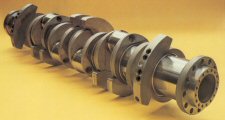 Crankshaft: Main shaft of engine to which the flywheel is fitted and which is coupled to the machinery being driven. The shaft has main journals which run in the main bearings fitted in the crankcase. It also has cranks with crankpins to which the big ends of connecting rods are attached.
Crankshaft: Main shaft of engine to which the flywheel is fitted and which is coupled to the machinery being driven. The shaft has main journals which run in the main bearings fitted in the crankcase. It also has cranks with crankpins to which the big ends of connecting rods are attached.
Picture: Paxman Valenta crankshaft
Crankpin: Short cylindrical bearing surface between two arms of a crank (i.e. between the two webs connecting it to the crankshaft), which is set parallel to the main shaft of the crankshaft. Attached to, and running on, each crankpin is the big end bearing of a connecting rod, or two big end bearings in the case of a side by side arrangement, or a bearing block in the case of a fork and blade arrangement.
Damper or Crankshaft Damper or Torsional Vibration Damper: Fitted at free end of crankshaft of high-speed, multi-cylinder diesels to reduce the peak torsional stresses in the crankshaft. The most widely used type is the 'viscous damper', filled with a viscous silicone fluid. Other types are 'shear in rubber' and 'mass on spring'.
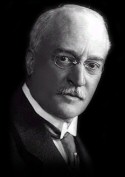 Diesel, Dr Rudolf (1858-1913): Considered by many to be the inventor of the compression ignition engine which is now generally referred to as a diesel. Rudolph Diesel patented his invention in 1892 while working for MAN in Augsburg. The engine described in his patent was fuelled by coal dust, injected into the combustion chamber by compressed air. Diesel's invention was based solely on theoretical work and a working example, using oil as the fuel, was not developed until about five years later. His first licence was bought by Mirrlees Watson of Glasgow who started building his engines in 1897. Akroyd Stuart registered his patent two years before Diesel's, and by 1891 had actually built working prototypes incorporating his invention. Diesel mysteriously disappeared on an overnight steamer crossing from Antwerp to Harwich in September 1913. His body was later found in the sea. Various theories abound as to whether he accidentally fell overboard, or committed suicide (he was in severe financial difficulties at the time) or was assassinated by German or French agents.
Diesel, Dr Rudolf (1858-1913): Considered by many to be the inventor of the compression ignition engine which is now generally referred to as a diesel. Rudolph Diesel patented his invention in 1892 while working for MAN in Augsburg. The engine described in his patent was fuelled by coal dust, injected into the combustion chamber by compressed air. Diesel's invention was based solely on theoretical work and a working example, using oil as the fuel, was not developed until about five years later. His first licence was bought by Mirrlees Watson of Glasgow who started building his engines in 1897. Akroyd Stuart registered his patent two years before Diesel's, and by 1891 had actually built working prototypes incorporating his invention. Diesel mysteriously disappeared on an overnight steamer crossing from Antwerp to Harwich in September 1913. His body was later found in the sea. Various theories abound as to whether he accidentally fell overboard, or committed suicide (he was in severe financial difficulties at the time) or was assassinated by German or French agents.
Direct Injection: Injection of fuel direct into the cylinder of an engine rather than into a pre-chamber built into the cylinder head. Contrast indirect injection. Direct injection engines are better suited to pressure charging and high speed operation than indirect injection types. They are also more fuel efficient and have better starting characteristics at low temperatures.
Drive End: End of engine at which the flywheel is attached to the crankshaft and at which the crankshaft is coupled to the main piece of machinery being driven, such as an alternator, gearbox, or propeller shaft. Contrast free end
Dynamometer: Machine used to measure an engine's power output. Often coupled to an engine on a test bed.
Exhaust Gas Recirculation (EGR): System used in all modern automotive diesels, which recirculates a proportion of the exhaust gases back into the intake system, via an electronically controlled valve to precisely control the quantity. The gases are usually passed through a cooler first to increase their density. EGR reduces the available oxygen in the charge air thus reducing the peak combustion temperature as the burn is not as efficient. The system substantially reduces the level of NOx emissions, but at the cost of increasing particulate emissions.
Firing Pressure - often referred to as Maximum or Peak Firing Pressure: The maximum pressure in the cylinder, and thus the load on the piston crown, during combustion. The firing pressure is determined by an engine's compression-ratio, the charge-air boost pressure and the fuel injection timing. It is also affected by the rate of fuel injection and the quantity of fuel injected. Maximum firing pressure can be measured using an indicator gauge.
Flap valve or Air shut-off flap valve: Safety device which shuts off supply of combustion air if an engine overspeeds and does not respond to the governor, overspeed trip, or manual operation of the fuel rack. Without air the fuel cannot burn and the engine comes to a stop.
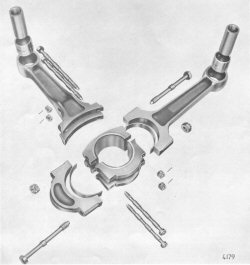 Fork and blade connecting rods: A connecting rod arrangement which allows the cylinders of one bank of a vee form engine to be placed directly opposite the corresponding cylinders of the other bank. This makes it possible to build a shorter length engine than one with side by side connecting rods. Fork and blade rods are made and fitted in pairs. The big end of one rod forks into two and is attached to a bearing block running on one of the crankshaft's crankpins. The big end of the other rod, whose small end is connected to the piston in the corresponding cylinder of the other bank, fits like a blade between the forked end of its paired rod, and is attached around the bearing block. In the illustration to the right, the forked con-rod is in the top left corner, the two halves of the bearing block are together in the centre, and the two main sections of the blade con-rod are in the top right and bottom left corners. Also shown are bolts and nuts for securing the bearing block to the forked rod and the bottom section of the blade rod to its top section.
Fork and blade connecting rods: A connecting rod arrangement which allows the cylinders of one bank of a vee form engine to be placed directly opposite the corresponding cylinders of the other bank. This makes it possible to build a shorter length engine than one with side by side connecting rods. Fork and blade rods are made and fitted in pairs. The big end of one rod forks into two and is attached to a bearing block running on one of the crankshaft's crankpins. The big end of the other rod, whose small end is connected to the piston in the corresponding cylinder of the other bank, fits like a blade between the forked end of its paired rod, and is attached around the bearing block. In the illustration to the right, the forked con-rod is in the top left corner, the two halves of the bearing block are together in the centre, and the two main sections of the blade con-rod are in the top right and bottom left corners. Also shown are bolts and nuts for securing the bearing block to the forked rod and the bottom section of the blade rod to its top section.
Four Stroke: Operating principle employed in the majority of diesel (and petrol) engines. The four stroke cycle commences with the induction stroke during which the piston moves from the top to the bottom of the cylinder and charge air is drawn or fed under pressure into the cylinder. During the compression stroke the piston moves to the top of the cylinder, compressing the charge air. In a diesel engine the fuel is injected and ignition commences fractionally before the piston reaches its top position. Then follows the power stroke during which the combustion of fuel takes place and the pressure of the expanding combustion gases forces the piston down the cylinder. Finally, during the exhaust stroke, the piston rises to the top of the cylinder, expelling the exhaust gases. The sequence has been succinctly and graphically described as suck, squeeze, bang, blow. All Paxman-designed diesels have been four stroke. Compare two stroke.
Free end: Opposite end of an engine to the drive end. Large diesels usually have a damper fitted at the free end, as on all Paxman engines. Ancillary equipment, such as a cooling fan or water pump, is frequently driven from the free end.
Fuel pump: In a diesel engine, fuel is injected into the cylinder under high pressure using a fuel pump. There are different types of pump, such as the block pump, individual fuel pump, and unit injector pump.
Fuel Rack / Fuel Pump Rack: Toothed bar which meshes with the plunger of a fuel pump, rotating it to increase or decrease the amount of fuel injected into a cylinder immediately before the power stroke. Racks are linked to the fuel control rod which is connected to, and operated by, the engine governor.
Indirect Injection: Form of fuel injection in which fuel is injected not directly into the cylinder but into a small chamber (typically a Ricardo Comet chamber) adjoining it. Combustion starts in this chamber before travelling along the small passage or throat connecting it to the cylinder. Indirect injection does not require the higher injection pressures required for direct injection. Compared with direct injection engines, those with indirect injection are quieter running, but not as fuel efficient or well suited to turbocharging or high speed operation. (Contrast Direct Injection)
Injector: Device for injecting fuel into a cylinder just before commencement of the power stroke. Fuel under very high pressure is forced through a nozzle at one end of the injector where it is atomised and enters the cylinder as a fine mist. Good distribution of fuel and charge air within the cylinder is aided by the shape of the cylinder head and piston crown which are designed to create swirl. If the injector nozzle becomes partially blocked or worn, some of the fuel may not be properly atomised but enter the cylinder as droplets. Not all of this fuel will be fully burned, resulting in a smokey exhaust, higher fuel consumption and reduced power output. Servicing injectors is a highly skilled business requiring special equipment as the holes in nozzles are exceptionally fine and easily damaged.
Intercooling: Arrangement in a pressure charged engine for cooling the charge air after it has been compressed but before it enters the cylinders. During compression, typically by a turbocharger, the temperature of the air rises and it expands to occupy a greater volume, i.e. becomes less dense. Cooling the compressed air increases its density and thus the quantity which can be fed into each cylinder for combustion. This increases the amount of fuel which can usefully be injected into each cylinder and in turn the potential power output of the engine. Intercooling further enhances performance because cooler charge air allows greater expansion of the exhaust gases during each power stroke and provides an additional element of engine cooling.
There are two main types of intercooling - air to water and air to air. In the first the heat exchanger matrix through which the charge air passes is surrounded and cooled by a flow of water. In the second the matrix is cooled by a flow of air.
Journal: Part of a shaft or axle in contact with, or enclosed by, a bearing.
kWb - kiloWatt brake: Metric measure of power output. Compare bhp. 1kWb = 1.34bhp.
Main Bearing: Any of the large bearings fitted into, and forming part of, the crankcase which enclose and support a crankshaft main journal
Naturally or Normally Aspirated: Term referring to an engine in which the charge air enters cylinders under atmospheric pressure only. Contrast turbocharging and supercharging. Naturally aspirated engines are simpler and cheaper to manufacture but produce substantially less power than a similarly sized pressure-charged engine.
NOx emissions: Nitrous Oxide emissions, as found in diesel engine exhaust gases. Modern engine designers aim to keep these to a minimum for environmental reasons. The quantity of NOx emissions generated is a function of gas temperature and pressure during combustion. In some engines fitted with common rail fuel injection systems the level of NOx emissions is reduced by having two or more injection 'events' during each cycle, to achieve a lower rate of rise in cylinder pressure during combustion. Measures to reduce NOx emissions usually result in increased particulate emissions so the engine designer has to aim for the best balance between the two types of emission.
Oil Engine: The name often used and preferred by some engineers for a compression ignition or diesel engine. However, it should be noted that some early low compression engines running on benzine, petrol or paraffin and using spark ignition were also referred to as oil engines.
Ovality: Refers to wear on crankshaft journal or connecting rod bearing which has resulted in the circumference of the journal or bearing becoming oval rather than round. Caused by the very heavy loading on these components during the power stroke of a diesel engine.
Overspeed Trip: Device designed to shut down an engine if its speed rises above a safe maximum. A diesel engine has no natural top speed and under certain conditions its speed can continue to increase until the engine destroys itself unless an overspeed trip is fitted. See also flap valve and runaway.
Particulates: Small solid particles found in diesel engine exhaust, typically composed of carbon (soot).
Pressure charged: Term referring to an engine in which charge air is fed to the cylinders under greater than atmospheric pressure. With a larger charge of air available for combustion, more fuel can be injected in each cycle thus increasing an engine's potential power output. See turbocharging and supercharging. Contrast naturally aspirated.
Runaway: Diesel engine which fails to respond to the usual controls and continues to accelerate after reaching its safe maximum speed, with consequent risk of major damage or disintegration. A truly frightening situation with a large high speed diesel and one where a rapid exit of all personnel in the vicinity is the safest course! Even after the normal fuel supply is shut off the engine may continue to run, fuelled by lubricating oil vapour drawn past the piston rings from the sump. The risk can be controlled by fitting an air shut-off flap valve.
Semi-diesel: A type of early compression ignition oil engine first developed by Akroyd-Stuart. It requires the application of heat from an external source, such as a blow lamp, to a 'hot bulb' to aid ignition until the engine reaches normal working temperature. The term distinguishes this type of engine from what was described during the 1920s as a cold starting engine and the modern diesel engine.
Shaft Horsepower (SHP): Used to denote power output from the drive shaft rather than from the engine itself - for example where the engine has an integral gearbox as in the case of the Deltic. Commonly used with reference to engines used for marine propulsion.
Side by Side Connecting Rods: An arrangement in which the big end bearings of two connecting rods run side by side on a single crankpin of the crankshaft. It is the more common arrangement in a vee form engine. The small end of one rod is attached to a piston in an A bank cylinder, the small end of the other being attached to the piston in the opposite B bank cylinder. The arrangement requires the position of cylinders in one bank to be offset, lengthways along the engine, from those in the opposite bank. This makes for a slightly longer engine (by the thickness of one connecting rod) than one with fork and blade connecting rods but the complexity and cost of side by side connecting rods is substantially less.
Smoke: Term used to refer to diesel exhaust which looks black and smokey, rather than clear, because of the presence of unburnt fuel oil. Smoke in exhaust of a cold engine is not abnormal as full combustion of fuel is often achieved only when an engine reaches normal working temperature. Smoke in exhaust at normal working temperature may indicate that fuel is not being fully combusted due to blocked or worn injector(s), or fuel pump not producing required pressure, or faulty timing of point of injection, or air starvation (e.g. choked air filter or turbocharger fault), or a combination of these. Blue tinged exhaust smoke suggests that lubricating oil is being burnt, perhaps due to worn piston rings or some other fault allowing lubricating oil into the cylinder(s).
Spring Injection: A successful early form of solid or mechanical fuel injection introduced at a time when air-blast injection was the norm for larger compression ignition engines. Introduced by Blackstone of Stamford in the early 1920s and used by Paxman in their vertical heavy-fuel-oil engines from 1925 until the early 1930s. It was superseded by injection systems which were better suited to the higher speed diesels developed in the 1930s and after.
Supercharging: Method of pressure charging a diesel (or petrol) engine. Charge air is fed to the cylinders under greater than atmospheric pressure using a compressor or 'blower'. The method differs from turbocharging in that the compressor or blower is positively driven, usually from the engine crankshaft. Whilst supercharging achieves better boost pressures than turbocharging at lower engine speeds, a disadvantage is the amount of the engine's power absorbed in driving it. Superchargers on some early large industrial diesels were driven by another smaller engine. Supercharging was tried on various types of engines, with varying degrees of success, up to the 1950s but has now been superseded by turbocharging for both diesel and petrol engines. Compare turbocharging
Swept Volume: of a cylinder is the volume swept by the piston as it reciprocates. It is calculated by multiplying the length of stroke by the cross-sectional area of the piston. To find the swept volume of an engine this figure is multiplied by number of cylinders.
Swirl: Orderly swirling motion of the charge air inside the combustion space, to aid mixing of this air with the atomised fuel as it is injected. Thorough mixing of the air and fuel is essential to good combustion. Swirl is achieved by designing cylinder heads, air inlet ports, valves and piston crowns so that the required motion is set up in the charge air as it enters the combustion space and is then compressed.
Thermal Cycling: Cycle of changing temperatures within an engine, particularly a large diesel, when it goes from idling or low load conditions to full load, and vice-versa. The variations in temperature are accompanied by expansion and contraction of key components which may lead to stress and fractures. Thermal cycling can be a particular problem in rail traction applications which involve frequent changes in engine load.
Turbocharging: Most commonly used method of increasing the pressure under which charge air is fed to a diesel engine's cylinders. The larger quantity of air made available in the cylinder for combustion allows a greater quantity of fuel to be injected and fully burned during each cycle thus increasing an engine's potential power output.
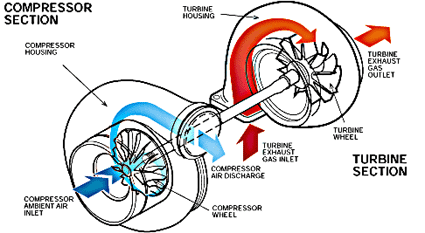
A turbocharger consists of a turbine and a centrifugal compressor mounted on opposite ends of a common shaft. The turbine, driven by the engine's exhaust gases, turns the shaft which drives the compressor used to boost the pressure of the intake or charge air. Diesels are particularly well-suited to turbocharging and modern engines are running at far higher levels of turbocharging than those previously found in F1 racing cars. A diesel engine's power output can be further enhanced by combining turbocharging with intercooling. Compare Supercharging and Naturally Aspirated.
Twin Bank: Engine with two banks of cylinders, parallel to each other, and two crankshafts geared together to a common output shaft. The crankshaft speed and output shaft speed often differed.
Two-Stage Turbocharging: A system of turbocharging in which charge air is first compressed by one or more low-pressure compressors. The charge air compressed during this first stage is then compressed again by one or more high-pressure compressors during a second stage, before being fed to the engine's inlet manifold. Two-stage turbocharging is employed on the Paxman VP185 range of engines.
Two Stroke: Operating principle employed in some very large 'cathedral' type marine propulsion diesels, some small model compression ignition engines, and some small petrol engines. The complete operating cycle occurs during only one revolution of the crankshaft, rather than the two revolutions required in a four stroke engine. During the upward stroke of the piston exhaust gases are blown out of the cylinder and the new charge of air compressed. When the piston reaches the top of the cylinder, the engine begins its power stroke which ends with a fresh charge of air being inducted into the engine. Key advantages of the two stroke are that one stroke in two is a power stroke (rather than the one in four of a four stroke) and simplicity of construction with no valves or valve gear. Disadvantages are poor scavenging of exhaust gases after each power stroke and higher fuel consumption. Paxman's only two stroke involvement was with the Deltic engine, an unusual and exceptionally complex design of two stroke, originally developed by D Napier & Son of Acton, London. Compare four stroke.
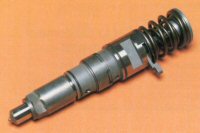 Unit Pump Injector: Fuel pump and injector incorporated in a single unit , one unit being fitted for each cylinder. The pump is operated either mechanically, for example by a camshaft, push rod and rocker arm, or electronically. Among advantages of unit pump injectors are absence of high pressure fuel lines with their attendant risks of fracture, lower initial cost compared with separate pumps and injectors, and greater ease of replacing faulty units.
Unit Pump Injector: Fuel pump and injector incorporated in a single unit , one unit being fitted for each cylinder. The pump is operated either mechanically, for example by a camshaft, push rod and rocker arm, or electronically. Among advantages of unit pump injectors are absence of high pressure fuel lines with their attendant risks of fracture, lower initial cost compared with separate pumps and injectors, and greater ease of replacing faulty units.
Valve Gear: Inlet and exhaust valves together with their operating gear. It controls the flow of intake air into, and exhaust gas from, each cylinder.
Vee Form Engine: Engine having two lines or banks of cylinders, one on each side. The two banks are set at an angle to each other so that looked at from the front or rear of the engine they form a V shape. Typically the angle of the vee is between 60° and 90°.
Acknowledgements: My thanks to Malcolm Frost and Graham Howard who kindly agreed to read through the initial draft for this page and made a number of helpful suggestions. Malcolm was formerly Personnel Manager at Paxman and my 'boss' there for over ten years. Graham was Engineering Director at Paxman from 1985 to 1988 before returning to Mirrlees Blackstone at Stockport to become its Engineering Director until he retired. Responsibility for any errors or inaccuracies in the above information must rest with me.
Page updated: 11 FEB 2015
